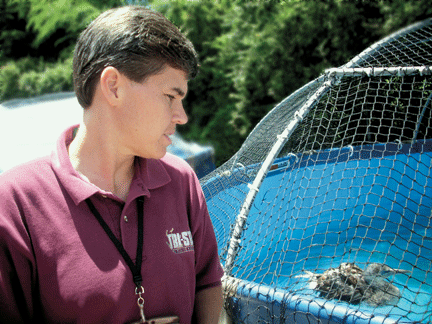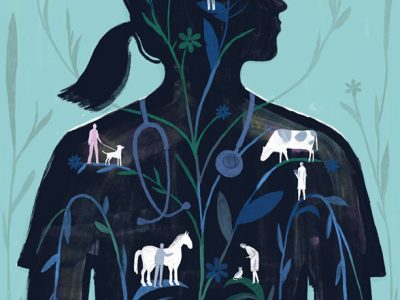
Class of ’91 | When the long-distance caller identified himself as a BP executive on the morning of April 26, Heidi Stout V’91 paid careful attention.
Talking fast, the alarmed-sounding BP manager explained that his company was struggling with a problem in the Gulf of Mexico. It was a problem that might require the services of Tri-State Bird Rescue and Research, the Newark, Delaware-based wild-bird rescue organization that Stout heads.
Could Stout fly to New Orleans ASAP, he wondered, in order to “assess an environmental situation on the Gulf” and maybe even do some “preliminary planning,” should it eventually prove necessary to rehabilitate some oil-covered birds?
Stout’s answer was an emphatic Yes. Less than two hours after answering that dramatic phone call, in fact, she was hurrying through a Philadelphia airport.
“As veterinarians who specialize in rehabbing wild birds, we’re on a two-hour call-out,” she later told the Gazette. “And as soon as I heard what was at stake in the Gulf, I knew I had to go. If you recall, the Deepwater Horizon oil rig had sunk to the bottom of the Gulf on the 22nd, only four days before—and that had triggered what looked like it might be a major oil spill. By the 26th, when the call came in, we knew this had the potential to become an environmental catastrophe.”
By six o’clock that evening, accompanied by her top lieutenant—Sallie Welte V’88, Tri-State’s clinical director—Stout was sitting down with a team of very anxious oil-company managers in a New Orleans office.
Their concern was understandable. The BP oil spill was about to become the biggest environmental disaster of its kind in US history—unleashing 20 times the amount of crude that escaped during the 1989 Exxon Valdez Alaska spill. By the time BP finally managed to cap its gushing well in mid-July, the spill had sent an estimated 200 million gallons of toxic crude spewing into the Gulf. It had also caused an estimated $5 billion to $10 billion in economic losses, as the region’s huge seafood and tourism industries took a major hit.
The spill also posed a major threat to the millions of fish, turtles, and wild birds that make the Gulf region their home. How much of the raw crude would invade the beaches and marshlands of the Gulf Coast, where many wild birds and other sea creatures (such as the region’s majestic loggerhead turtles) raise their young? How would the giant spill affect the feeding habits of Gulf birds—the northern gannets, brown pelicans, and laughing gulls that give this fragile coastal zone its distinctive character?
As the weeks passed and the oil continued to pour into the Gulf, those questions took on growing urgency. But Stout, a 20-year veteran of wild-bird rescues that often take place in the middle of horrific oil spills and other high-profile toxic events, kept her cool.
“The BP spill was different in that it covered a wide geographical area and had the potential to affect many different species of birds,” she said during a late-July interview at a wild-bird rehab facility that she and Tri-State had set up in Pensacola, Florida. “But then again, every oil spill is unique—in terms of the area it covers and the species on which it has an impact—and you have to shape your response accordingly.”
Having helped to lead a successful rescue of 20,000 oiled penguins during a spill off South Africa in 2000, Stout was unfazed by the geographical enormity of the challenge she faced in the Gulf. Within a month—and after carefully analyzing the spill data she was receiving daily from BP, the Coast Guard, and the US Fish and Wildlife Service—she and the other 12 full-time staffers at Tri-State moved quickly to launch wild-bird rehabilitation centers in the four states (Louisiana, Mississippi, Alabama, and Florida) most affected by the event.
At the centers, long-established veterinary guidelines for rehabbing oiled birds called for first “stabilizing” the birds by examining them for dehydration, starvation, and injuries such as damaged wings or eyes. Once the birds were medically stable (usually within a few days of being brought to a center), they could be washed clean in specially designed tanks.
After a typical rehab of two to three weeks, the rejuvenated birds—mostly northern gannets and brown pelicans, both of which are vulnerable to surface oil when diving for food—were released back into the wild.
“For the younger birds, early release is extremely important,” said Stout. “These are fledglings, and it’s important for them to get back out there learning how to be a pelican.”
A Pittsburgh native who fell in love with wild birds in grade school (“I was the kid in the neighborhood everyone called if a bird hit a window”), Stout majored in animal science at Virginia Tech, then immediately signed on as a veterinarian-in-training at Penn.
“The course work was helpful in many ways,” she remembers, “but I think I got the most out of the internships I did at local zoos and at Tri-State. For a veterinarian, working with the animals—up close and personal—is the key to learning the ropes, and Penn gave me a chance to do that. So I think it’s kind of cool that our wildlife vet at Tri-State, Dr. Erica Miller, is now teaching a course at Penn in wildlife medicine.”
Although Stout believes that the “jury is still out” on the ultimate impact of the spill, she says she’s encouraged by the federal environmental data she’s seen so far. As of early September, about 5,700 wild birds had died in the region due to injuries caused by the spill. Another 3,000 or so oiled birds had been collected alive, with more than two-thirds of them rehabbed and released.
“Up to now, I think we’ve been fortunate,” says Stout, whose idea of a good time is kayaking a wild river or hiking over a snowy mountain. “Thanks to the wide geographical range of the spill, the toxic impact has been less. The impact could have been much more devastating.
“But whether we save one bird or 20,000, we have to make the effort. If we as humans caused this problem, we have to fix it. For me, rescuing injured birds is a moral issue, and I really don’t think there’s a way to determine how much a bird is worth. How do you put a price tag on the life of a bird?”
—Tom Nugent




